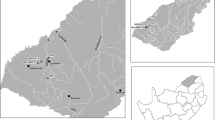Abstract
Once inputs of mercury-bearing effluents to a fluvial system are stopped, levels of contamination will decline slowly to background values. Crystalline mercury phases will dissolve in response to lowered aqueous mercury concentrations, and aqueous Hg(OH)2 will desorb from ferric hydroxide grain coatings as the coatings age to more ordered phases. In the Ottawa River, mercury concentrations in bed sediments are declining by about 50 percent annually.
Similar content being viewed by others
References
deGroot, A. J., J. J. M. de Goeij, and C. Zegers, 1971, Contents and behavior of mercury as compared with other heavy metals in sediments from the rivers Rhine and Ems: GEOL. en MIJNB., v 50, p. 393–398.
Hart, J. S., 1972, Overview and synopsis of the Programme,in Hart, J. S., (ed.). Distribution and transport of persistent chemicals in flowing water ecosystems: Ottawa, Canada, The Ottawa River Programme, Univ. Ottawa — National Research Council of Canada, Interim Rept. No. 1, (no successive pagination).
Hem, J. D., 1970, Chemical behavior of mercury in aqueous media,in Mercury in the environment: U.S. Geol. Survey Prof. Paper 713, p. 19–24.
Jenne, E. A., 1968, Controls on Mn, Fe, Co, Ni, Cu, and Zn concentrations in soils and water — the significant role of hydrous Mn and Fe oxides,in Trace inorganics in water: Advances in Chemistry Series, v. 73, p. 337–387.
Krauskopf, K. B., 1956, Factors controlling the concentrations of thirteen rare metals in seawater: Geochim. Cosmoch. Acta, v. 9. p. 1–32.
Kudo, A., and J. S. Hart, 1972, Mercury kinetics of bed and suspended sediments,in Hart, J. S., (ed.), Distribution and transport of persistent chemicals in flowing water ecosystems: Ottawa, Canada, The Ottawa River Programme, Univ. Ottawa — National Research Council of Canada, Interim Rept No. 1 (no successive pagination).
Langmuir, D., and D. O. Whittemore, 1971, Stability of ferric oxyhydroxides,in Non-equilibrium systems in natural waters: Advances in Chemistry Series, v. 106, p. 209–234.
Oliver, B. G., and J. Kinrade, 1972, Heavy metal concentrations in Ottawa River and Rideau River Sediments: Ottawa, Canada, Canada Inland Waters Directorate, Dept. of the Environment, Scientific Series 14, 10 p.
Waslenchuk, D. G., (in press). A new diveroperated bedload sampler: Am. Soc. Civil Eng., Jour. Hydraulics Div.
Author information
Authors and Affiliations
Additional information
Editor's note: Waslenchuk is now with the Georgia Institute of Technology School of Geophysical Sciences, Atlanta, Georgia 30332, U.S.A.
Rights and permissions
About this article
Cite this article
Waslenchuk, D.G. Mercury in fluvial bed sediments subsequent to contamination. Geo 1, 131–136 (1975). https://doi.org/10.1007/BF02428939
Received:
Revised:
Issue Date:
DOI: https://doi.org/10.1007/BF02428939




